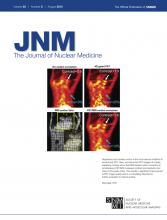REPLY: We appreciate Drs. Laffon and Marthan’s interest in our article relating with high precision the allergen-to-diluent ratio of the 18F-FDG uptake rate (Ki) to the allergen-to-eosinophil count. They wonder if the ratio of late SUV might also closely correlate with the ratio of eosinophil count. To examine this possibility, we reanalyzed our data using the last 10-min frame of our dynamic acquisition to calculate both a mean and a peak standardized uptake value (SUV) in the regions of interest for the right middle lobe (allergen) and right upper lobe (diluent). We plotted the allergen-to-diluent ratio of mean and peak SUV against the ratio of eosinophil counts and found coefficients of determination of 0.3944 (P = 0.18) and 0.0015 (P = 0.94), respectively, compared with 0.9917 (P < 0.001) for the 18F-FDG Ki ratio (1).
The reason for the marked difference in performance between SUV and Ki is unclear but may be due to the assumption that plasma activity is low in relation to tissue activity when SUV is calculated. Since SUV is the sum of both plasma activity and uptake, the ratio of SUV in the allergen-to-diluent regions of interest can closely approximate the ratio of Ki only when plasma activity is low relative to activity taken up by the tissue. In most organs, plasma volume is low compared with tissue volume, and this assumption is reasonable. However, in the lung, plasma volume is nearly equal to tissue volume, and plasma activity could be a substantial fraction of total activity in a region of interest, even late during imaging. This consideration may be particularly problematic in regions with slow uptake, such as the diluent lobe in our experiment, for which the error may be magnified when SUV is used.
Using dynamic 18F-FDG scans rather than late, static PET scans is more complicated, as it requires a rapid, smooth injection; multiple blood draws; and a single–bed-position acquisition. However, our laboratory has developed a method to reduce the number of arterial samples to derive an input function (2). With this method, we can take as few as 2 venous samples (we often take 5 or 6 in case of problems with sampling), which are used to “calibrate” an input function measured with PET from a region of interest defined over the right heart or the aorta. Granted, we still have to image continuously during injection, thus reducing the imaging field to a single bed position. Newer scanners are able to acquire larger fields of view, or alternatively, one can move the subject back and forth between 2 or 3 bed positions in order to acquire dynamic datasets.
Footnotes
Published online Jun. 4, 2012.
- © 2012 by the Society of Nuclear Medicine and Molecular Imaging, Inc.







